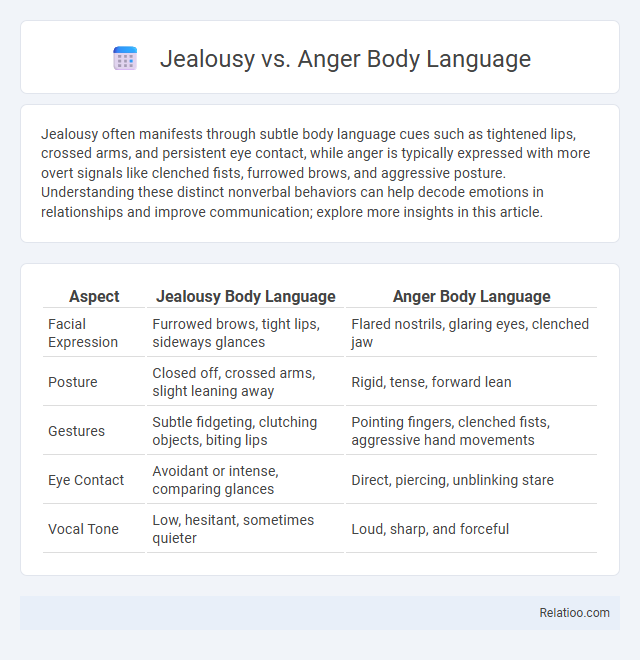Jealousy often manifests through subtle body language cues such as tightened lips, crossed arms, and persistent eye contact, while anger is typically expressed with more overt signals like clenched fists, furrowed brows, and aggressive posture. Understanding these distinct nonverbal behaviors can help decode emotions in relationships and improve communication; explore more insights in this article.
Table of Comparison
| Aspect | Jealousy Body Language | Anger Body Language |
|---|---|---|
| Facial Expression | Furrowed brows, tight lips, sideways glances | Flared nostrils, glaring eyes, clenched jaw |
| Posture | Closed off, crossed arms, slight leaning away | Rigid, tense, forward lean |
| Gestures | Subtle fidgeting, clutching objects, biting lips | Pointing fingers, clenched fists, aggressive hand movements |
| Eye Contact | Avoidant or intense, comparing glances | Direct, piercing, unblinking stare |
| Vocal Tone | Low, hesitant, sometimes quieter | Loud, sharp, and forceful |
Introduction to Jealousy and Anger Body Language
Jealousy and anger manifest distinctly through body language, with jealousy often showing signs of tension, avoidance, and guarded postures, while anger is characterized by clenched fists, furrowed brows, and direct eye contact. Your ability to recognize these nonverbal cues enhances emotional intelligence and improves interpersonal communication. Understanding these subtle physical expressions helps in accurately interpreting emotions behind words.
Defining Jealousy and Anger Nonverbal Cues
Jealousy nonverbal cues often include subtle signs like prolonged eye contact, tense posture, and crossed arms, indicating possessiveness or insecurity, while anger is expressed through more intense body language such as clenched fists, flared nostrils, and aggressive gestures. Your ability to recognize jealousy involves noticing guarded behaviors and microexpressions, whereas anger displays are more overt, with rigid body stances and direct, piercing glances. Understanding these nuanced differences in body language helps you accurately interpret emotional states and respond appropriately.
Facial Expressions: Distinguishing Jealousy from Anger
Jealousy often manifests through subtle facial expressions such as tight lips, narrowed eyes, and fleeting glances away, indicating discomfort or insecurity, whereas anger is characterized by more intense features like furrowed brows, flared nostrils, and clenched jaws signifying aggression. Microexpressions in jealousy tend to be brief and mixed with moments of vulnerability, while anger displays prolonged and consistent facial tension. Understanding these nuanced differences in nonverbal cues can aid in accurately interpreting underlying emotions within interpersonal interactions.
Eye Movements and Gaze Patterns
Jealousy often triggers prolonged and intense eye contact accompanied by frequent glances at perceived rivals, signaling suspicion and vigilance in your body language. Anger manifests through narrowed eyes, glaring, and rapid shifting of gaze that communicates hostility and heightened arousal. Understanding these subtle differences in eye movements and gaze patterns can help you accurately interpret emotions and respond effectively in social interactions.
Posture and Physical Stance Differences
Jealousy often manifests through closed, defensive postures such as crossed arms and sideways glances, signaling insecurity and guardedness. Anger is characterized by more aggressive stances, including leaning forward, clenched fists, and rigid shoulders, which indicate confrontation and readiness to assert dominance. These distinct nonverbal cues in posture reveal underlying emotional states and intent without verbal communication.
Gestures Associated with Jealousy vs Anger
Gestures associated with jealousy often include crossed arms, averted gaze, and subtle fidgeting, which signal insecurity and discomfort. In contrast, anger-related body language features clenched fists, tense jaw muscles, and direct, intense eye contact that convey aggression and confrontation. Recognizing these distinct nonverbal cues helps differentiate between the underlying emotions of jealousy and anger in social interactions.
Voice Tone and Speech Changes in Jealousy and Anger
Jealousy often triggers a softer, hesitant voice tone coupled with speech disruptions such as stammering or long pauses, reflecting internal conflict and insecurity. In contrast, anger typically manifests through a louder, sharper voice tone with faster speech and clipped sentences, conveying aggression and dominance. Your ability to recognize these distinct vocal cues can enhance emotional intelligence and improve interpersonal communication.
Microexpressions: Subtle Signs in Both Emotions
Microexpressions reveal the nuanced difference between jealousy and anger through subtle facial cues; jealousy often manifests as fleeting lip pressing, eye darting, or a brief furrowing of the brows, while anger tends to show as tightened jaw muscles, flared nostrils, and intense glaring. Nonverbal cues in jealousy involve subtle signs of insecurity or possessiveness, such as avoidance of direct eye contact or forced smiles, whereas anger exhibits more overt physical tension and aggressive posture shifts. Understanding these microexpressions enhances emotional intelligence by providing deeper insight into underlying emotional states beyond verbal communication.
Contextual Triggers in Body Language Displays
Jealousy typically manifests through subtle nonverbal cues such as narrowed eyes, crossed arms, and prolonged staring, often triggered by perceived threats to valued relationships. Anger body language is more overt, characterized by clenched fists, flushed skin, and aggressive posture, usually elicited by frustration or direct conflict. Contextual triggers shape these displays, with jealousy arising in social comparison scenarios and anger emerging in response to immediate provocations.
Recognizing and Responding to Jealousy and Anger Cues
Jealousy often manifests through subtle nonverbal cues such as crossed arms, lowered gaze, or forced smiles, while anger is typically expressed with more overt behaviors like clenched fists, flushed skin, and intense eye contact. You can recognize jealousy by observing signs of discomfort or insecurity, whereas anger is marked by aggressive posture and abrupt movements. Responding effectively involves maintaining calm body language to de-escalate tension and using empathetic gestures to acknowledge and address underlying emotions.

Infographic: Jealousy vs Anger body language
 relatioo.com
relatioo.com